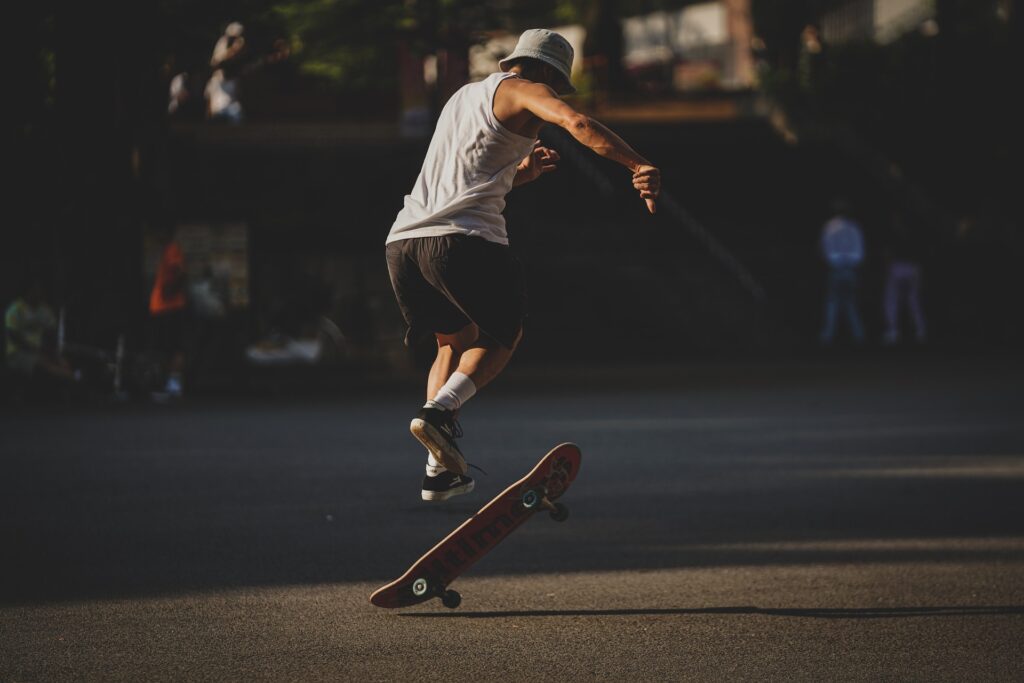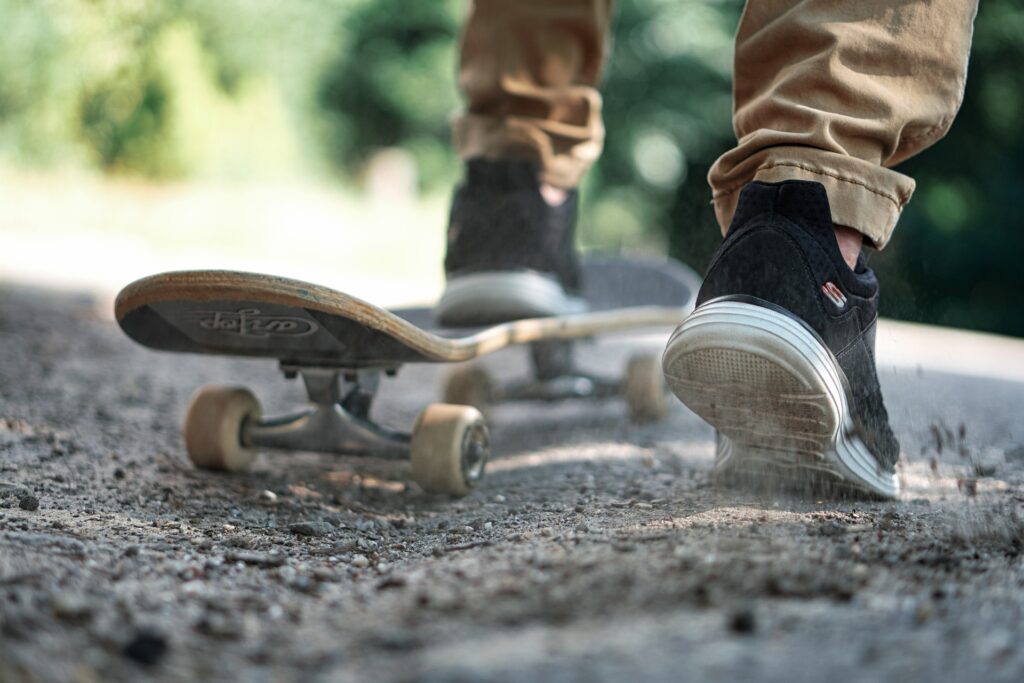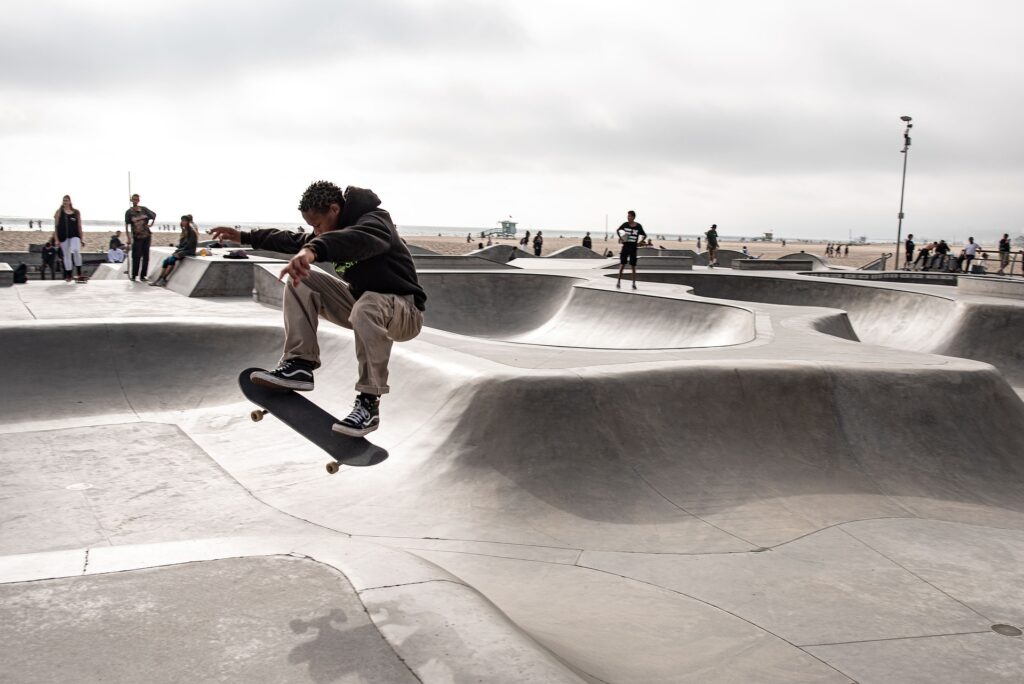Introduction – Fall Safely While Skateboarding
Do you want to try skateboarding but fear injury from falls? Fear not! Knowing how to fall safely while skateboarding is an essential part of having a successful and enjoyable experience. In this blog post, I will provide some helpful tips on how to fall safely while skateboarding. With these techniques under your belt, you’ll be able to confidently get up and take steps onto your board without the fear of getting hurt. So buckle up, because today we’re learning all about falling correctly while skateboarding.

Skateboarding’s First Rule: Safety First
Learning how to fall correctly is just as important as staying on the skateboard and doing tricks when learning to skateboard. Yes, there’s a proper way to fall. Even if you weren’t very high off the ground, a skateboard fall can break bones or cause a concussion. You can’t be afraid to fall when learning to skateboard, or you won’t be confident.
Skateboarding without a helmet and pads is dangerous. You’ll learn the wrong way to fall as you fall repeatedly. As you improve, you should fall less often, but when you do, your body should move so you hurt less.
Tips On How To Fall Properly On Skateboard
We’ve compiled some of the best tips to help you fall safely and correctly.

1. Learning Proper Form and Posture
When you learn how to fall skateboarding, it is important to remember that your form and posture are key. As you begin to hop on the board, make sure that you stay balanced throughout the whole process. Keep your arms in a T-shape, shoulders back and down, and feet pointed downward with knees bent slightly outward.
Practice this technique regularly along with other safety precautions until it becomes an instinctual response – which will help you stay safe when skateboarding!
2. Wearing Safety Gear
One of the most crucial protective measures for a successful skate session is wearing safety gear. Helmets are especially important as they protect the head from any heavy impacts or falls. Did you know that 3.5%-13% of skateboarding injuries are classified as head trauma? This is according to two researchers at Idaho State University. Wearing elbow pads, wrist braces, and long pants can also reduce scrapes, bruises, and other injuries associated with falls.
Furthermore, adding knee pads will provide cushioning for the joints during hard landings and slides. Head-to-toe protection is imperative to ensure that ride time is comfortable and safe during skateboarding sessions.
3. Anticipating Obstacles in Advance
Skateboarders should pay close attention to what is ahead so they can brace for impacts and slow down if necessary. This will reduce the likelihood of a hard or dangerous fall. Oftentimes, a skater’s first reaction may be to jump or flail when they sense something coming; however, this can make it harder to land safely. Instead, try taking control and grabbing the board with both hands for balance when an obstacle arises.
It’s also helpful to keep the knees bent and slightly raised, as this helps absorb much of the impact when landing. By being deliberate and proactive with how you move your body, you’ll have a greater chance of having a successful (and safe) skating session every time!
4. Practicing Falls on Soft Surfaces
It’s not possible to master how to fall overnight, so incremental practice is key. One great way to do this is by practicing how to fall on soft surfaces like grass or a foam mattress. This will help you get used to how your body should react when falling off your board on skateparks or other hard surfaces.
Additionally, it’s crucial to keep your upper body relaxed and make sure your arms are close by so that they can break the fall and provide protection if needed. Making sure you understand the basics of how to fall properly on a skateboard on softer surfaces will give you greater confidence when facing tougher scenarios down the line.
5. Knowing When to Stop Skateboarding for the Day
One thing one should remember when skateboarding, especially for beginners, is when it’s time to stop for the day. A smart sign that it’s time for a break is feeling fatigued or dizzy. When physical exhaustion sets in, one is more likely to feel a lack of control and coordination, causing them to fall more easily.
There are other physical signals such as pain or soreness that indicate it’s time to take a break too. Skateboarding safely means taking pauses throughout the day and carefully listening to your body’s needs.
Another interesting read: Starting A Skate Club
Different Techniques Of How To Fall Skateboarding
Now that we’ve gone over some basics, let’s discuss the various techniques for falling safely and correctly in skateboarding.

Another interesting read: How To Skate Faster
Basic Fall
This is the most common way to fall as it allows you to remain in control of your body and movements. As you feel yourself start to lose balance, try shifting all your weight onto one side of the board. This will help you stay upright and freefall onto the ground while still maintaining control. You can also use your arms to break the fall and tuck your head in close to protect it
Bailout
This technique is best used if you find yourself in mid-air and feeling out of balance. You can intentionally bail by pushing the board away from your body and making sure that you land safely on your feet.
Foot Roll
The foot roll technique is often used when landing a trick or jumping off an obstacle. To do it properly, move both feet toward the nose of the board with arms raised to protect yourself from falling flat onto the ground.
Side Fall
This is a great way to prevent the board from slamming into your body if you’re unable to jump off. To side fall, turn the board sideways and bend your knees as you let yourself drop towards the ground. Keep both arms close to your chest for protection as well.
Slam
The slam is used when you’re feeling out of control and need to quickly get off the board. To do it, thrust your body forward while intentionally allowing yourself to fall sideways onto the ground.
Conclusion
Skateboarding is a fun and thrilling sport, but it does come with the risk of falling. Knowing how to fall safely while skateboarding will make your experience much more enjoyable and reduce the likelihood of injury. With some practice, patience, and dedication, you can become a skilled skater with confidence in your balance skills! So don’t be afraid to get up, take those steps and start your skateboarding journey today. Good luck!